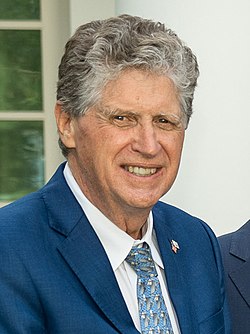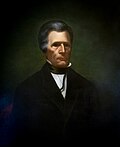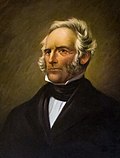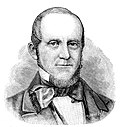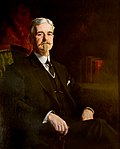Top Qs
Timeline
Chat
Perspective
List of governors of Rhode Island
From Wikipedia, the free encyclopedia
Remove ads
The governor of Rhode Island is the head of government of Rhode Island and serves as commander-in-chief of the U.S. state's Army National Guard and Air National Guard. The current governor is Dan McKee.
Remove ads
Governors
Summarize
Perspective
Rhode Island was one of the original Thirteen Colonies and was admitted as a state on May 29, 1790.[2] Before it declared its independence, Rhode Island was a colony of the Kingdom of Great Britain.
The state initially continued operating under the provisions of its 1663 charter, which simply said that the governor and deputy-governor would be elected from time to time. The 1842 constitution formalized the terms for governor and lieutenant governor to be one year, beginning on the first Tuesday of May after the election.[3] Amendment XVI, taking effect in 1911, changed the term to be two years beginning from the first Tuesday in the January after the election.[4] Terms were lengthened to four years in 1992, but governors were now limited to succeeding themselves only once.[5] A former governor can run again after a four year break. Should the office of governor be vacant, the lieutenant governor becomes governor.[6] The governor and the lieutenant governor are not officially elected on the same ticket.
Remove ads
See also
Notes
- Cooke was deputy governor when colonial governor Joseph Wanton was deposed on November 7, 1775, and was chosen to replace him.[8]
- As the office of lieutenant governor was vacant, President of the Senate Smith succeeded to governor.[18]
- Wilbour was instead elected to the United States House of Representatives.[18]
- No candidate received a majority of the vote for governor, so Lieutenant Governor-elect Wilbour acted as governor for the term.[23]
- Knight resigned, having been elected to the United States Senate.[31][32]
- No candidate received a majority of the vote for governor, and four run-offs were attempted during the year but all were similarly deadlocked. Arnold remained as governor, and in January 1833, the state legislature formalized it, permitting him to continue on as governor until the end of the term.[11]
- No candidate received a majority of the vote for either governor or lieutenant governor, so as First Senator, King served as acting governor for the year.[11]
- A constitutional convention, without consent from the legislature, convened in 1842 and, on May 2, proclaimed Thomas Wilson Dorr as governor, which led to a brief period of strife known as the Dorr Rebellion.[48]
- Allen resigned, having been elected to the United States Senate.[64]
- Turner lost the Republican nomination to Seth Padelford.[79]
- Sprague resigned, having been elected to the United States Senate.[82]
- As the office of lieutenant governor was vacant, President pro tempore of the Senate Cozzens succeeded to governor.[85]
- Howard represented the Republican and Prohibition parties.[96]
- Van Zandt represented the Republican and Prohibition parties.[73]
- Incumbent governor William Gregory was re-elected in November 1901, but died the next month, so Lieutenant Governor Kimball succeeded him.[137]
- San Souci lost the Republican nomination to Harold Gross.[158]
- Flynn instead ran unsuccessfully for the United States Senate.[159]
- Green was instead elected to the United States Senate.[166]
- McGrath resigned, having been confirmed as Solicitor General of the United States.[175]
- Pastore resigned, having been elected to the United States Senate.[178]
- Sundlun lost the Democratic nomination to Myrth York.[209]
- Under a 1992 amendment to the constitution, governors are ineligible to serve consecutively for more than two terms.[212]
- Chafee was elected as an independent, but on May 30, 2013, he joined the Democratic Party.[217]
- Raimondo resigned, having been confirmed as United States Secretary of Commerce.[219]
- McKee's first full term began on January 3, 2023,[222] and will expire on January 5, 2027.
Remove ads
References
External links
Wikiwand - on
Seamless Wikipedia browsing. On steroids.
Remove ads



